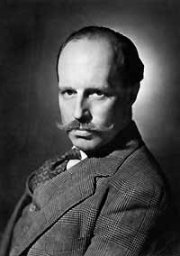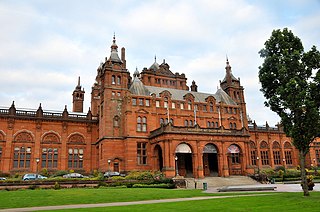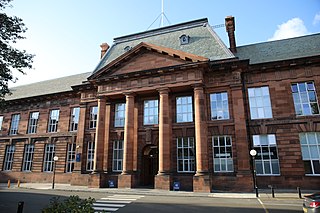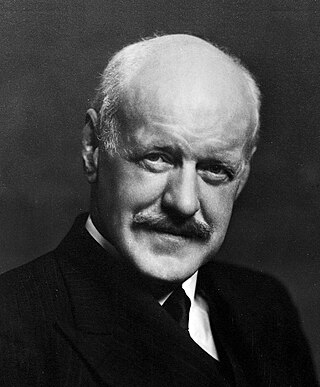
Broughton Place is a historic house in the village of Broughton, Scottish Borders. It was designed by Basil Spence in the style of a 17th-century Scottish Baronial tower house.

Broughton Place is a historic house in the village of Broughton, Scottish Borders. It was designed by Basil Spence in the style of a 17th-century Scottish Baronial tower house.
In 1935, professor Thomas Renton Elliott, [1] and his wife commissioned the Edinburgh architectural practice of Rowand Anderson, Paul & Partners to build the house. It was designed by the young and still unknown Basil Spence, then a partner in the firm, in a style far removed from his later modernist architecture. He worked closely with Mrs Elliott to meet her requirements. Work began in 1936 and was completed in 1938.
The house is brick-built and Harled, with wooden panelling and decorative plaster ceilings in the interior. The sculptor Hew Lorimer contributed a pair of relief panels and a pair of lion gateposts.
Broughton Place is situated on the site of an earlier house owned by John Murray of Broughton, secretary to Bonnie Prince Charlie during the Jacobite Rising of 1745. [2]
The house was converted into flats in 1975. [2] Until 2010, the ground floor housed a commercial art gallery, the Broughton Gallery, established in 1976, offering contemporary British art and crafts. [3]

The National is the national art gallery of Scotland. It is located on The Mound in central Edinburgh, close to Princes Street. The building was designed in a neoclassical style by William Henry Playfair, and first opened to the public in 1859.

Sir Basil Urwin Spence, was a Scottish architect, most notably associated with Coventry Cathedral in England and the Beehive in New Zealand, but also responsible for numerous other buildings in the Modernist/Brutalist style.
Brutalist architecture is an architectural style that emerged during the 1950s in the United Kingdom, among the reconstruction projects of the post-war era, but commonly known for its presence in post-war communist nations. Brutalist buildings are characterised by minimalist constructions that showcase the bare building materials and structural elements over decorative design. The style commonly makes use of exposed, unpainted concrete or brick, angular geometric shapes and a predominantly monochrome colour palette; other materials, such as steel, timber, and glass, are also featured.
The year 1976 in architecture involved some significant architectural events and new buildings.

Kelvingrove Art Gallery and Museum is a museum and art gallery in Glasgow, Scotland, managed by Glasgow Museums. The building is located in Kelvingrove Park in the West End of the city, adjacent to Argyle Street. Kelvingrove Art Gallery and Museum is one of Scotland's most popular museums and free visitor attractions.

Sir Robert Rowand Anderson, was a Scottish Victorian architect. Anderson trained in the office of George Gilbert Scott in London before setting up his own practice in Edinburgh in 1860. During the 1860s his main work was small churches in the 'First Pointed' style that is characteristic of Scott's former assistants. By 1880 his practice was designing some of the most prestigious public and private buildings in Scotland.

Edinburgh College of Art (ECA) is one of eleven schools in the College of Arts, Humanities and Social Sciences at the University of Edinburgh. Tracing its history back to 1760, it provides higher education in art and design, architecture, history of art, and music disciplines for over three thousand students and is at the forefront of research and research-led teaching in the creative arts, humanities, and creative technologies. ECA comprises five subject areas: School of Art, Reid School of Music, School of Design, School of History of Art, and Edinburgh School of Architecture & Landscape Architecture (ESALA). ECA is mainly located in the Old Town of Edinburgh, overlooking the Grassmarket; the Lauriston Place campus is located in the University of Edinburgh's Central Area Campus, not far from George Square.
Sir Robert Hogg Matthew, OBE FRIBA FRSE was a Scottish architect and a leading proponent of modernism.

Broughton is a village in Tweeddale in the historical county of Peeblesshire in the Scottish Borders council area, in the south of Scotland, in the civil parish of Broughton, Glenholm and Kilbucho and Upper Tweed Community Council. Broughton is on the Biggar Water, near where it flows into the River Tweed. It is about 7 km east of Biggar, and 15 km west of Peebles.

Mortonhall is an area of Edinburgh, Scotland, on the south edge of the city.

Thomas Smith Tait was a Scottish modernist architect. He designed a number of buildings around the world in Art Deco and Streamline Moderne styles, notably St. Andrew's House on Calton Hill, Edinburgh, and the pylons for Sydney Harbour Bridge.
Sir William Hardie Kininmonth was a Scottish architect whose work mixed a modern style with Scottish vernacular.

Hutchesontown C was a Comprehensive Development Area (CDA) of an area of Hutchesontown, a district in the city of Glasgow, Scotland. Its centrepiece were two Brutalist 20-storey slab blocks at 16-32 Queen Elizabeth Square, designed by Sir Basil Spence and containing 400 homes. Acclaimed by architects and modernists, the flats became riddled with damp and infestations, which could not be cured even with a major renovation in the late 1980s. They were demolished in 1993, with the demolition contractor using twice the amount of explosive necessary to destroy the building, killing a female spectator in the process.

Duncanrig Secondary School is a secondary school within the town of East Kilbride in the South Lanarkshire council area in Scotland. The original building was designed in 1953 by the Scottish architect Basil Spence.

Walter Archibald Elliott, Lord Elliott, MC was a Scottish lawyer and judge. In 1971, he became the first president of the newly established Lands Tribunal for Scotland, and in 1978 took on the additional office of chairman of the Scottish Land Court. Since then, both offices have been held concurrently.

Thomas Renton Elliott was a British physician and physiologist.
Events from the year 1938 in Scotland.

Zeev Aram, OBE was a British furniture and interior designer. He was the founder and chairman of Aram Designs Ltd, a modern furniture store in London's Covent Garden serving both the retail and contract market. He is responsible for introducing to the London market designers such as Marcel Breuer, the Castiglioni brothers, Mies van der Rohe, and Le Corbusier.
The Mortonhall Crematorium is a multi-denominational crematorium in Edinburgh, Scotland. It is an example of Basil Spence's post-war expressionist style. Opened in 1967, the crematorium is set in mature woodland and is a Category A listed building. A walled memorial garden opened there in December 2015.
Bellevue is a district of Edinburgh, the capital of Scotland. It lies to the south east of Canonmills, west of Leith Walk and south of Leith, incorporating the easternmost extent of Edinburgh's New Town UNESCO heritage site. The area was formerly open fields which became the second and penultimate location of the Royal Botanic Garden in 1763 .